CHAPTER 3
TRANSITION MOBILE PHONES, 1958-67
Near the end of the 1950's, GE and Motorola began introducing mobile telephones with a few improvements over the original MTS phones of 1947. One of the improvements was the use of transistors in the radio power supply instead of vibrators and dynamotors, and miniature tubes with greatly decreased battery drain. Reliability went up as well. Another improvement was that the majority of mobile telephones being produced during this era had multiple channel capability. The 41A control head was discontinued by the mid 1950's, and new equipment was supplied with the 47A through 47E series control heads only. There were accessory boxes which contained a multiple channel switch for use with the type 47 control head.
The GE Progress Simultaneous Duplex (DTD/DTO/DTR)
By far the most revolutionary car telephone improvement of the late 1950's was the "duplexer", a radio frequency filter which allowed the transmitter of the VHF high band mobile telephones to go on the air while the receiver was still listening, using the same antenna. This operation is called "full duplex" and allows the subscriber to use the mobile telephone in much the same way he would a regular home telephone, since it was now possible to listen while talking. GE was apparently the first manufacturer to introduce a duplexer into a conventional mobile telephone during this period; it was installed in the new "Simultaneous Duplex" series Progress Line mobiles, which also contained a new rotary selector of Secode Corporation manufacture. The duplexer was a small rectangular can mounted on the front panel of the mobile radio. Although these mobiles were full duplex, it was still necessary to "push to talk" on the handset to put the transmitter on the air. Full duplex in these mobile radiotelephones simply meant the receiver would no longer be muted when the handset button was pushed. This equipment used the same receiver and transmitter as the earlier non-duplex equipment, although extra shielding was installed along with the duplexer. Motorola equipment would not feature a duplexer until 1964's TLD-1000 series radio. Some low volume manufacturers such as ITT Kellogg and AC-Delco also offered duplexers at the same time, so it's not exactly clear which manufacturer was technically first with this feature.
Probably the second most important feature introduced with this series phone was the dial on the control head. This was the first time that subscriber self-dialing was offered. This system was referred to, logically, as "Dial" and "Identified Dial," both providing that the subscriber could dial their own calls without the need for operator assistance. Please note that Dial systems were not IMTS systems, which were not introduced until 1964 and which used a different format and were more advanced than Dial and not compatible with it at all.
CLICK HERE for a technical explanation of Dial and Identified Dial.
Dial systems were used mainly by independent telephone companies but also by a few Bell affiliates. They saw service even into the late 1970's, long after IMTS had been introduced, probably because Dial systems were cheaper to buy and maintain. The AT&T mobile telephone nationwide channel guide in 1974 still shows a substantial number of systems using Dial, mainly independents. This must have been confusing for roaming users since there was no explanation that Dial was different from IMTS, and the two were not compatible.
Simultaneous Duplex equipment came in three models:
DTO: Operator dialed ( Manual) no dial in head
DTD: Mobiles may dial (Dial)
DTR: Mobiles may dial + identify automatically (Identified Dial)
The GE Simultaneous Duplex used a control head manufactured by GE, unique to their equipment. The handset hung up across the top of the housing, as on the older Western Electric 47A. This equipment could be obtained with up to five channels and was available for VHF only, although there is anecdotal evidence that a UHF version may have been made after 1963 in small quantities. There was no "Highway" low band version, although there was a "simplex" configuration of the DTO style mobile which could be specially ordered with low band "strips" inside. The DTR/DTD could be configured with various options, such as "busy channel lockout" and "reverting". Reverting simply means that if a call was made on a non-home channel, the mobile would "revert" to listening on the home channel when the call was completed and the handset hung back up. This was done electromechanically using a solenoid interlinked with the channel selector mechanism.
The DTO did not use a bell for a ringer; instead, a speaker was used to produce a high pitched audio tone. The limousine rear seat extension option consisted of a second control head, and a slightly modified control cable. The DTD or DTR prefix refers to equipment with the dial. DTO is the equipment labeled "Manual" in the photo. The DTR prefixed equipment is the same as DTO, the difference being that the rotary decoder was configured to "step by itself" to out-pulse the mobile's ID to the terminal so that no operator intervention was required at all. With the DTD, on the other hand, while the subscriber could dial, the operator still had to come on the line to ask for the mobile's ID for billing purposes. The DTR operated in close to the same way as the IMTS phones of the future would, except that there was no channel scan for marked idle or automatic channel selection, nor was the radio unit locked in the always-on transmit mode during a conversation. Note that the DTD and DTR series telephones were rarely used by any Bell affiliates and were found usually in Independent Telco service and in sales literature. Also note that there is some irregularity in the appearance of these heads. The actual example of a DTO head below does not have the third "Busy" yellow lamp shown in the factory photos, and unlike the factory photos has a push-in switch added (apparently not standard since the escutcheon is not labeled as to its purpose) which activated the "AUX" feature (automobile's horn blows when a call is received.)
Typical DTO Series manual control head as used in San Jose, California on the Pacific Bell MTS system:
FOR MORE PHOTOS OF GE DTO SERIES EQUIPMENT, CLICK HERE
The "Spark Plug" (Achieverphone) by AC Spark Plug Division
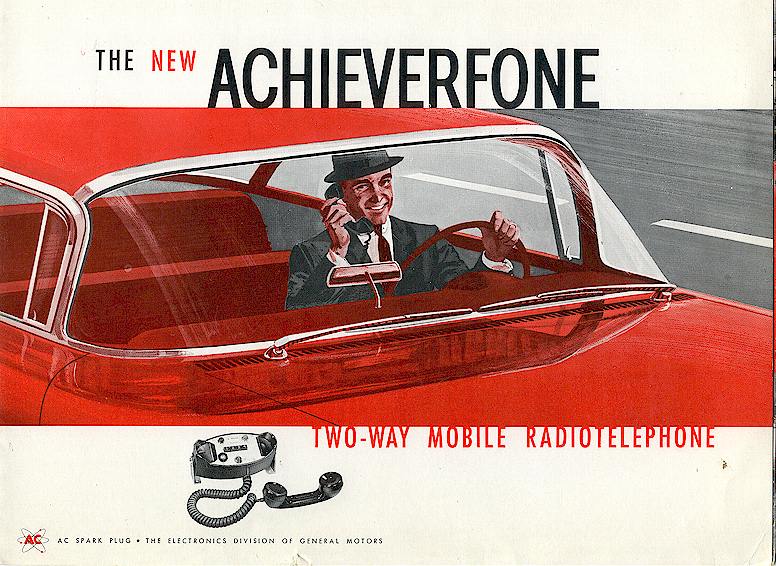
Independent manufacturers began to surface during this period, although mobile telephones were still almost exclusively controlled by the Bell System (AT&T), owned by them, and leased to the subscriber at a rather outrageous monthly rate. One unusual independent manufacturer of a mobile telephone in 1960 was the AC Spark Plug Division of General Motors. The AC Spark Plug "AChieverphone" saw service for a brief period of time in at least the Chicago and San Francisco/San Jose California area, as well as eastern cities (possibly Detroit.) The Achieverphone used a proprietary 4-channel control head and cable rather than a Western Electric type. It had a transistorized power supply and a built-in selector which used a plastic decoder wheel. While compact, it did not represent any significantly new features or concepts in mobile telephony. Statements from General Motors at the time predicted that in "a few years" the mobile telephone would be standard equipment on all new cars. The AChieverphone was evidently their attempt to "get a foot in the door" of that future market. It was an idea about thirty years ahead of its time. There was apparently no rear seat extension option for limousines. Another, apparently later, version featured a duplexer, but unfortunately my collection does not feature an example or any documentation on that model to provide here. Some were labeled "Delco" (see below) but most seem to have been labeled AC Spark Plug, giving this radiotelephone the nickname "Spark Plug."
A Delco marked Spark Plug control head:
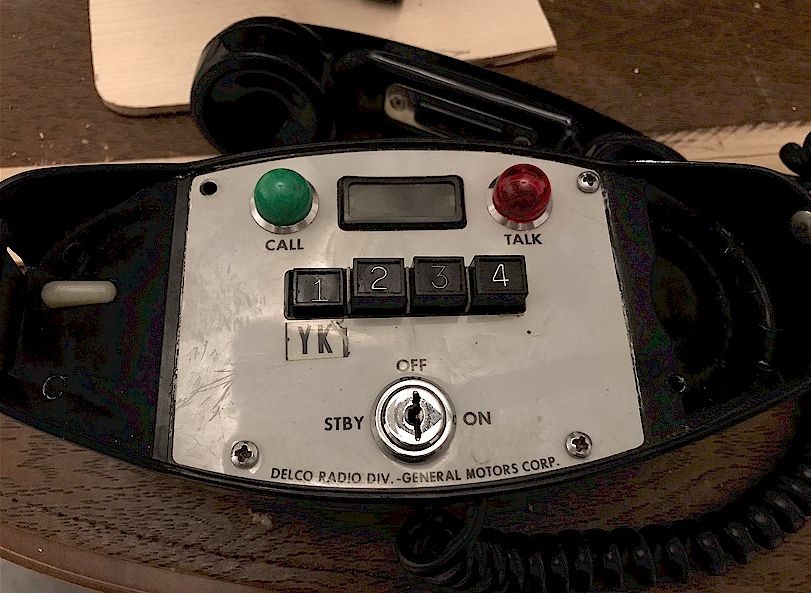
Another Achieverphone:
Seen on eBay in early 2021 was the Achieverphone head shown below. It apparently went with a more modern radio drawer in that the DC high voltage power supply for the radio is built into the control head in this model. It is unknown what the companion radio drawer looked like. Obviously the handset had a separate cradle. Interesting is that this version has a speaker on the bottom of the control head, usually absent in a mobile telephone.
The Skyphone:
AC Spark Plug Division also manufactured a UHF aircraft telephone at the same time called the "Skyphone," presumably quite similar to the Achieverphone internally, but in a aircraft "ATR" package as shown below. Control head details are unknown. Models were at least the CAT-2 and CAT-3.
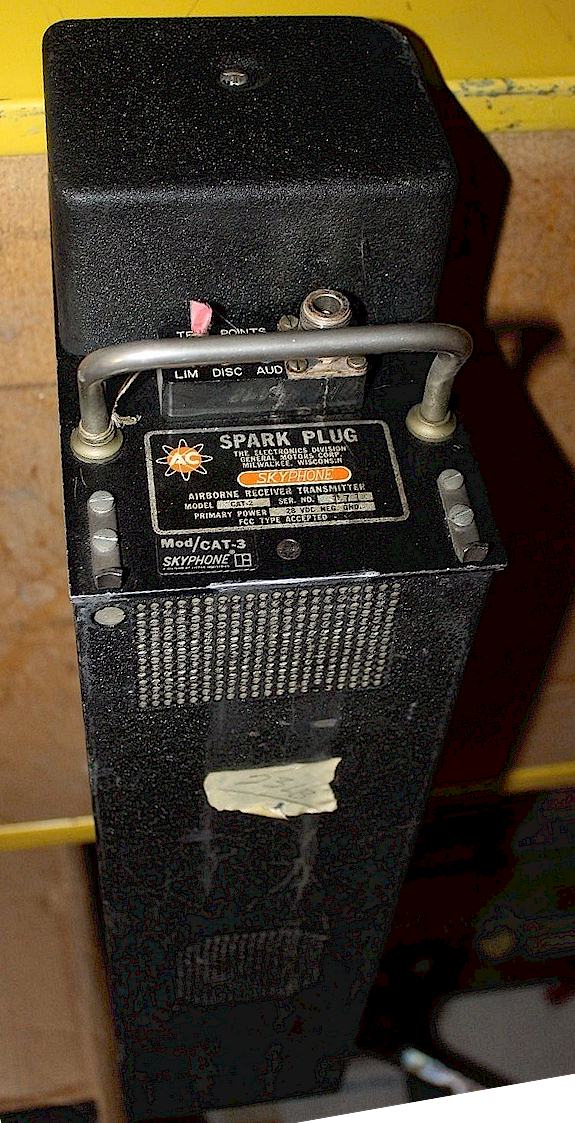
The ITT's
During this period, ITT, presumably via its ITT-Kellogg division near Chicago, made a number of MTS mobile phones which emulated Motorola products in features and components. Production of these mobile telephones appears to have stopped by 1964 at the latest, and few have survived. Some of the various models were prefixed KH-. They are believed to have all been manual, vacuum tube models using Secode manufactured internal selectors, with the final model/s featuring a duplexer, but still MTS. There are examples of the Cinderella head marked "Duplex" and "Dial," suggesting some were made for the "Dial" radio telephone system which pre-dated IMTS. The radio package resembled a Motorola "T-Power" transistor-powered mobile, and contained a maximum of five channels. Rear seat extension accessories are believed to have been available for limousines. The control heads used components of the "Princess" style home telephone, and the model was referred to as the "Cinderella" as shown below.
Note that despite having a dial, this phone was not IMTS. The dial was either non-functional or used in a Secode "Dial" MTS signaling system. Anyone owning such a mobile telephone is encouraged to shed light on this. The five lamps represent the channels and there is a stepper relay which steps through the channels via a pushbutton on the top rear of the control head.
After ITT exited the mobile telephone business it continued to supply MJ Series control heads to Motorola, GE and possibly others as an OEM manufacturer. The mobile telephone production rights and parts were apparently sold to Industrial Radio of Chicago, Illinois, which briefly tried to market an IMTS phone similar to the one shown below called the "Aristocrat" in 1964-66. See photos and description of the Aristocrat in later pages on this site.
ITT Cinderella:
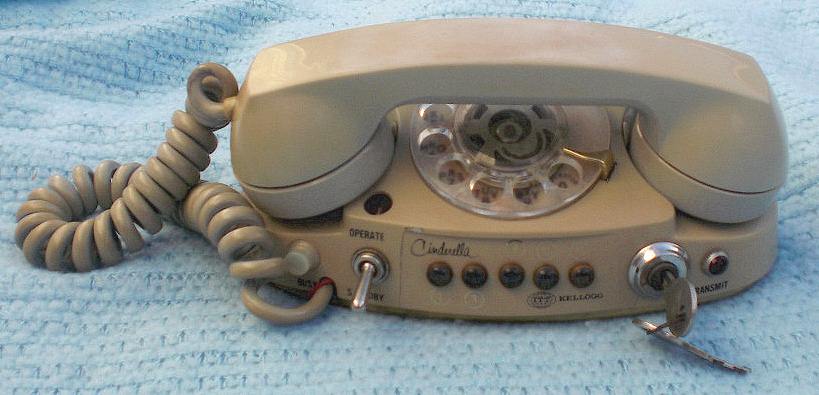
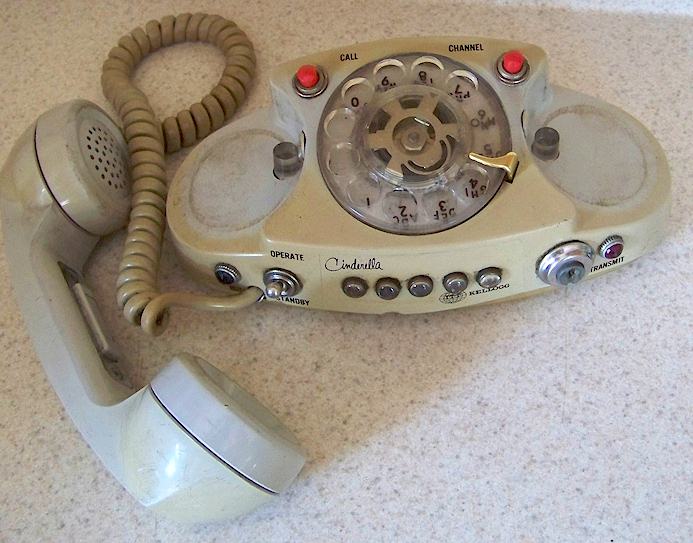
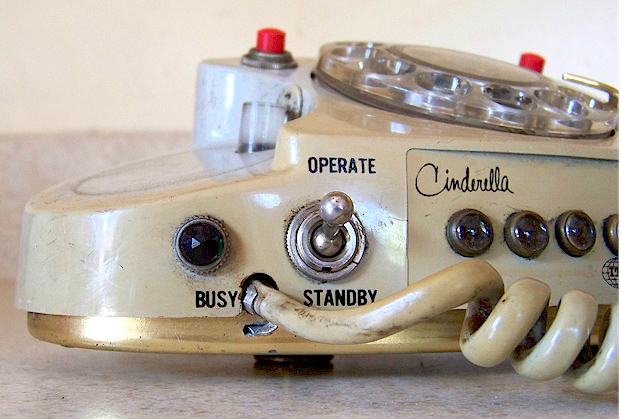
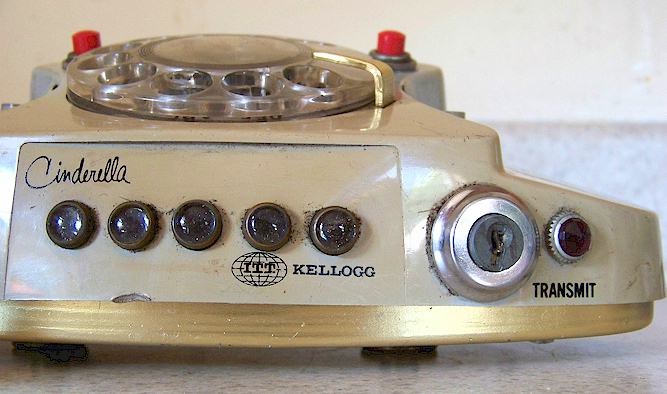
Shown below is an ITT Autocom 2 channel control head from an MTS system, earlier than the above head. Note the surprisingly crude appearance and that the head is made out of a non-dial Automatic Electric style "Princess" bedroom telephone.
Photos from an eBay auction
March, 2012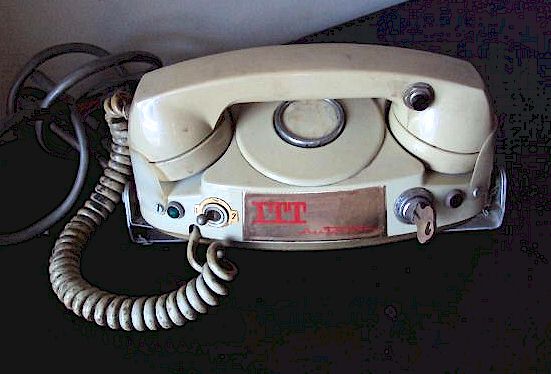
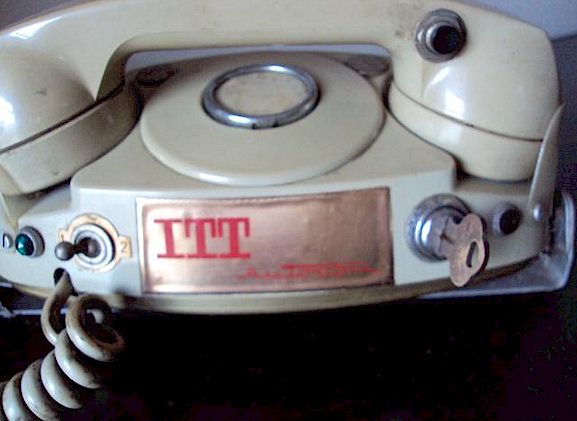
The Scantlin Selectors and the 47E Control Head
In the late 1950's, a Los Angeles area inventor named John Scantlin designed a transistorized mobile selector (tone decoder) to replace the now "venerable" Western Electric 102A mechanical stepper selector. Without any moving parts, the Scantlin SE-1315 selector was capable of more mobile number combinations than the old mechanical 102A, and therefore it was adopted by the Bell companies in the more populated urban areas where new numbers were needed. The control head used with the Scantlin selector was the Western Electric 47E. Rather than designing an entire new control head, Western Electric took the 47A series and modified it by placing a small hearing-aid type earphone into a machined hole in one end of the control head housing, which could be driven by an audio oscillator in the Scantlin selector, instead of the traditional mechanical bell ringer located in a separate junction box. The manual refers to this as "the transducer." The Scantlin selector consisted of a number of small plug-in circuit cards, on a long rack, each containing a transistor and several other components. Technicians who serviced the units at the time have related that the Scantlins were somewhat temperamental and temperature sensitive, and were not well liked. Nonetheless, the Scantlin equipment was the standard Bell System decoder until the introduction of Motorola's MTS and IMTS solid state TLD-1000 and TLD-1100 radio packages in 1964. The Western Electric number for the Scantlin selector was KS-16850-L4 .
The Western Electric 47E head with Scantlin selector was a typical car telephone in urban areas of the United States from about 1960 through 1965. The radio equipment mated to it was usually one of the "W" prefixed Motorola "Twin-V" mobile packages of the 25 Watt variety.
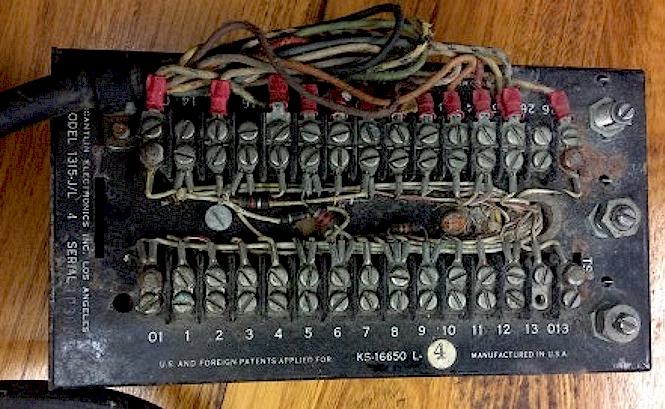
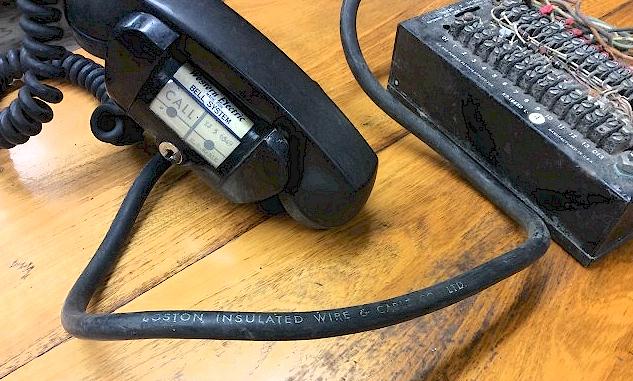
THE WABCO - SECODE EQUIPMENT
This equipment possibly belongs in the later IMTS pages as that is what it was designed for, although at least the model below has only 5 channels and thus does not meet the full "MJ" IMTS standard of 11 channels.
WABCO stands for Westinghouse Air Brake Company, a division of Union Switch and Signal. The radio division of WABCO seems to have been created in the early 1960's, anecdotally by a group of engineers who came from RCA's mobile radio division. The WABCO radio division primarily if not exclusively made radio equipment for railroads, which was the primary business of WABCO itself. WABCO's radio division seems to have been gone by approximately 1970.
In at least one instance, WABCO briefly produced a mobile telephone as an OEM manufacturer. The WABCO radio package below was a railroad product dating from approximately 1964 supplied to Secode Corp. with added components for mobile telephone use and badged "Secode." Secode was a leading manufacturer of tone signaling equipment prior to IMTS development but for some reason was not picked by AT&T as the contract manufacturer for the signaling system equipment, only for the "MJ" control head.
Secode tried to break into the mobile radio market on its own, intending to sell to the independent telephone companies as a "niche" market, and needed an RF package to go along with their line of tone signaling and control head equipment. The model below does not contain 11 channels, rather 5, as apparently these were supplied in versions less than the full 11 channels. It required an external signaling package as WABCO was not interested in manufacturing everything inside the mobile drawer. A Secode control head was employed. The model below has a duplexer mounted in it so that the telephone would be full duplex. Apparently there were cabling modifications made to the original WABCO radio to allow supervisory operation from an external unit, which required a number of additional wires.
The WABCO equipment is extremely rare today as few were been sold, other than as samples and prototypes, and it is one of the most unusual products. Unfortunately I have no photos of the signaling unit. There was a WABCO mobile telephone offered as a Buy-it-Now on eBay for something around $ 2500 which of course never sold, and the only photo was of a standard IMTS "MJ" style control head.
The Secode IMTS mobile telephone was the drawer unit shown below, with a rather large external signaling and supervisory unit in its own separate box, and a standard Secode "MJ" control head. As mentioned, very few were made, as the independents did not choose them in the end, other than a small number of "trial" units. Secode invested a rather large sum of money into this project, which was essentially lost, although in later patent litigation, AT&T wound up paying Secode for infringing its IMTS patents, among other items deemed Secode's intellectual property.
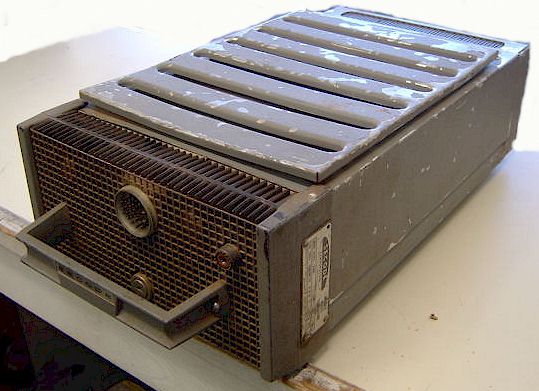
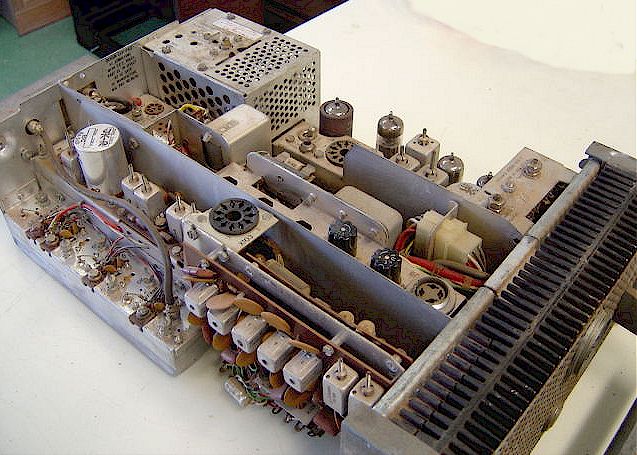
There was also an earlier Secode mobile telephone drawer which looked similar to this, but which had a different screened front and the block letters "SECODE" in chrome attached to the screen. The only one the author has seen was in the surplus two-way dealer Mann Communications (Agoura, Calif.) warehouse in 1971 and is believed to have been an all tube MTS radiotelephone and not made by WABCO. Anyone with information on either the Secode or WABCO phones is encouraged to share it!
The Motorola MTS Radiotelephone
Motorola was not napping when GE came out with the DTO- series transistor powered Progress Line radiotelephone with built-in selector and duplexer, although GE's duplexer appears to have beaten Motorola to the market by several years. Motorola's choice was to introduce a completely new design, a thoroughly modern mobile telephone with built-in duplexer and solid state selector, about half the size of GE's DTO, and which was almost fully transistorized. Motorola's TLD-1000 series "MTS" mobile was marketed in July 1963, and drew heavily upon the design innovations featured in their "Motrac" line of conventional two-way radios. The only vacuum tubes used were the power amplifier and driver of the transmitter. There were no relays; all switching was done with transistors. The basic platform of the TLD1000 called for the capability to expand up to 11 channels, based upon the FCC decision in the early 1960's to "split" existing VHF channels and require "narrow band" 5 KHz deviation (versus the old "wide band" 15 KHz deviation standard in mobile systems). The TLD-1000 was developed under the IMTS contract mentioned below, however it was initially sold as an MTS radio to be compatible with existing MTS systems, and to be upgraded later to full IMTS capability.
The TLD-1000 used its own unique control head, with two rows of clear plastic pushbuttons to select the necessary channels. The basic, central portion of the control head can be seen to be a copy, in plastic, of the original Western Electric 47 series control head. This Motorola unit was fully accepted by Western Electric and usually will be found with an orange painted "WE" number stamped on the chassis, but was also assigned a "KS" number by Western Electric. The equipment could be configured for "battery saving", which involved splitting the power input wiring for the transmitter from the receiver. Unlike competitor's equipment, the Motorola set used the exact spacing of the transmit and receive frequencies, in MHz, as the receiver's IF frequency. In this way, it was only necessary to install one crystal per channel, which was used by both the transmitter and the receiver. In the TLD1000, the selector is mounted on a hinged bracket underneath the main chassis. A rear set extension control head was available for limousines. The "MTS" TLD1000 radio is essentially the same chassis as in Motorola's famous "MJ" TLD1100 radio, which is described later under "IMTS" equipment.
Note that the MTS control head shown in the brochure photo below was also sold with an external MTS decoder for use on conventional Motrac radio drawers, which were not duplex. This setup was usually found on the low band "Z" channel equipment, which was never a duplex system, although some VHF MTS systems used conventional Motrac radio drawers as well, generally for telephone company owned vehicles and service crews.
There is an interesting example of the TLD-1000 head in use in the opening scenes of the James Bond film Live and Let Die where Bond is in the back seat of a CIA Chevrolet in New York and the driver takes a call (before being shot and losing control of the car.)
REAR SEAT EXTENSIONS (Limousines)
There was a rear seat extension unit for the TLD 1000 MTS phone, as shown below:
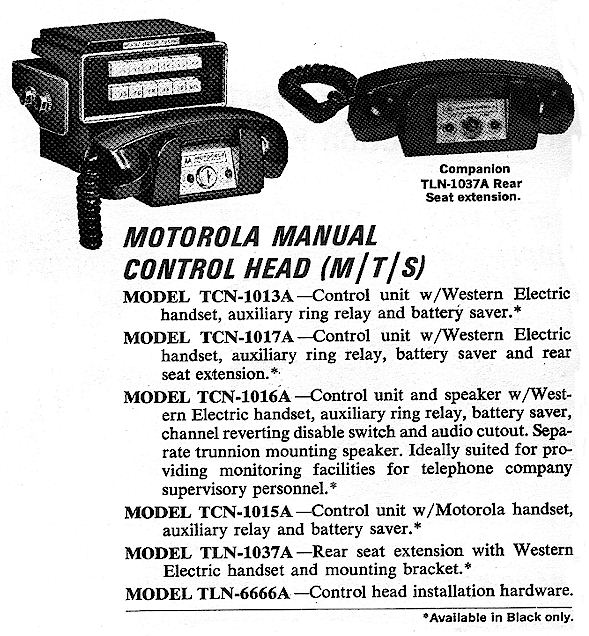
PYE (ARC) Cambridge (United States Communications + others)
A rather obscure MTS Bell System mobile telephone was briefly imported by Aircraft Radio Corporation (ARC) which was actually made by the British PYE Radio company, as the Cambridge VHF FM radio. This was a four channel set which made use of Ledex rotary relays for channel selection. PYE (ARC?) foresaw the phone as being sold with an external decoder (MTS only, model not disclosed) and an Automatic Electric - Starlite / Princess style control head. The ARC labeled PYE radios were sold by a number of third parties for a few years in the early 1960's. Note that there were many PYE models labeled Cambridge - - this is just one of them.
For some reason at least one mobile telephone service shop, United States Communications (Los Angeles, no relation to U.S. Communications of Idaho) chose to buy only the PYE radio drawer and manufactured their own heads and cable sets, using the Bell System Scantlin transistorized decoder or Secode rotary decoders and modified Automatic Electric "Starlite" telephone control heads. Other shops did the same with some variation in accessory connections and wiring.
The PYE set is very robust in terms of the case and mount construction, however the internal circuitry is unremarkable. The ARC advertising flyer says that the rotary dial on the head performed some sort of function (there was no direct dialing in MTS systems) while the rotary dial on the United States Communications head was completely non-functional. There were also essentially identical sets made for use with Bell Canada systems, using the same Starlite phone head but without the dial.
This set is not duplex and is push-to-talk only, as in a conventional mobile radio. It is a bit unusual in the it is rather full of relays, both conventional and rotary "Ledex" style types.
Anecdotal evidence suggests that the PYE radio drawer was also used with the GTE Lenkurt "Autotel" independent car telephones of the early 1960's, described elsewhere in this website.
Click here for a pdf file of the above 2 page brochure. 1.6 Mb pdf file download. Be sure if printing that Adobe Reader is set for "fit to printable area."
Click here to see a great video clip from a "Mod Squad" episode showing this phone !
The PYE radio drawer:
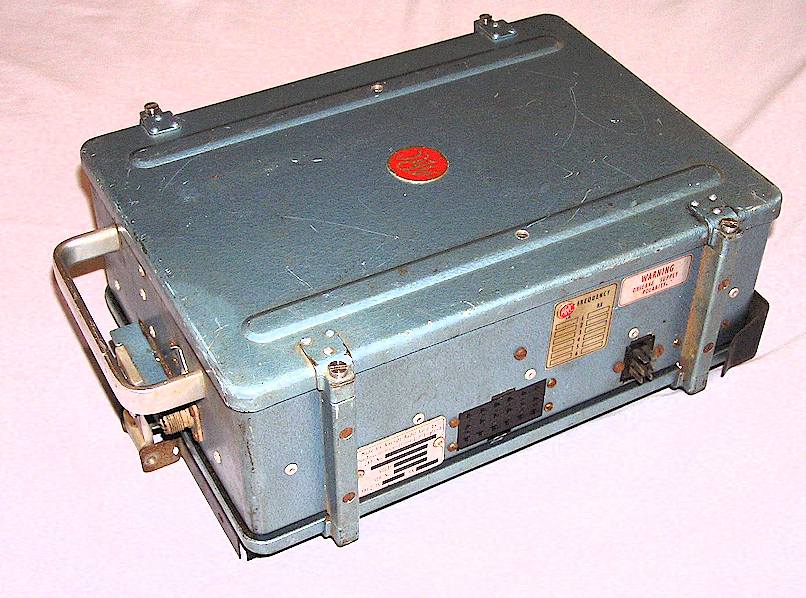
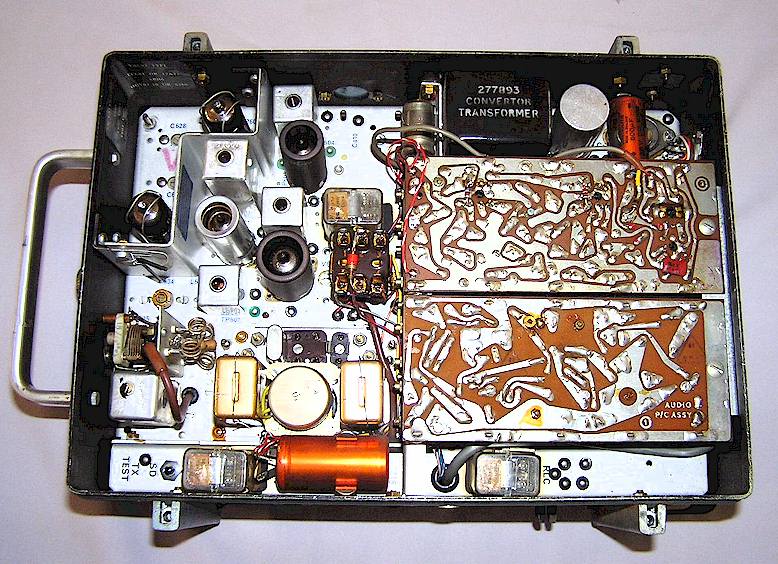
Some have added interface connector as below:
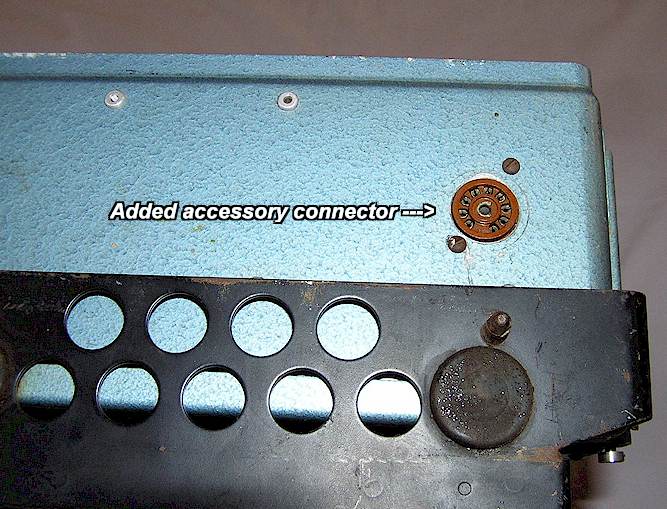
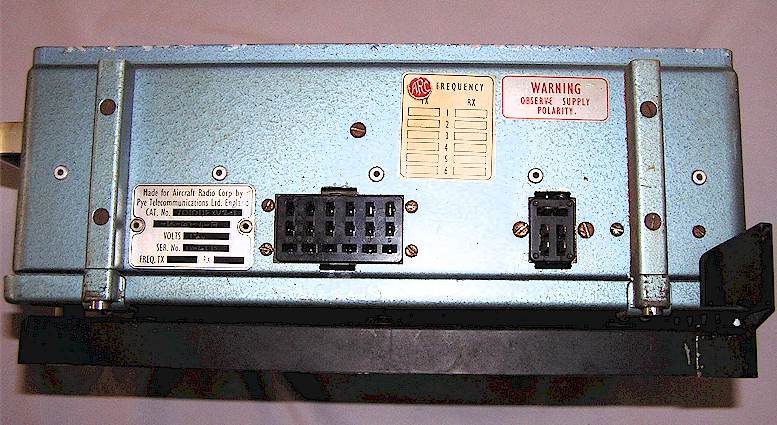
Unites States Communications models have this nameplate:
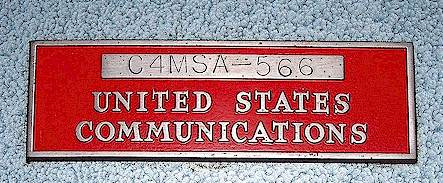
and these modifications on the side:
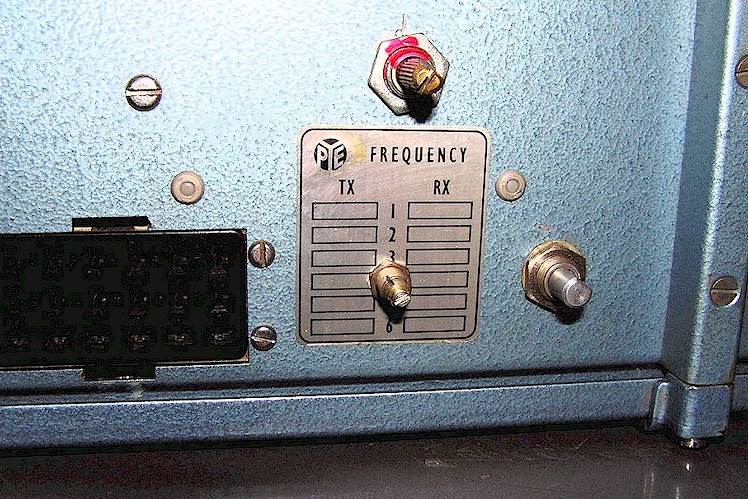
Other MTS Telephone Makes and Models Prior to 1964
There are no doubt a number of other makes and models of MTS mobile telephones not mentioned here. It is believed that Secode Corporation of San Francisco manufactured a mobile telephone in the approximate 1960 period, possibly relying on component modules supplied by existing mobile telephone manufacturers. Secode normally produced aftermarket selective calling and signaling equipment, and the electromechanical selector equipment for GE equipment through 1966. Other manufacturers included Industrial Radio Corp., International Systcoms of Canada, Mobile Communications Co. (Los Angeles) and the DuMont Corporation. For almost the duration of Bell System mobile telephone service, independent dealers found such equipment very hard to get, and this situation drove the creation of some unusual phones such as the PYE/U.S. Communications "Cambridge" above, and newer phones such as the Canyon and CSI equipment described later. The independent small dealers had issues purchasing equipment direct from Motorola or GE and were forced to use refurbished items to a large extent. At this time, they were in competition with the telephone company. Any mobile telephone, even a used-refurbished one, sold for in excess of $ 1000, and the profit margin for independents could be substantial (unlike today, where the profit margin on a cell phone itself is well into the negative region, only the number itself representing value to the carrier and reseller.)
Click here for photos of antennas over the years
Ver. 11/18/2021 ęGeoffrey C. Fors 2005 All rights reserved